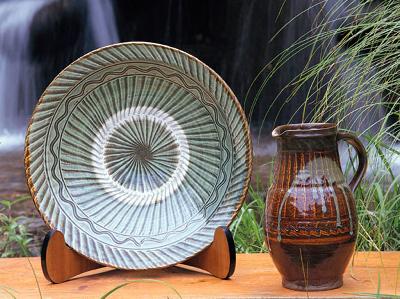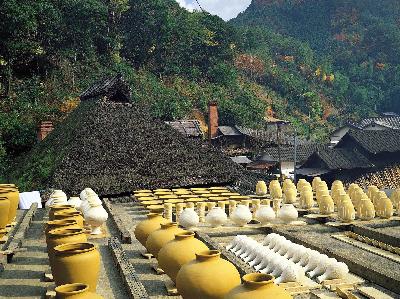小鹿田焼 Onta-yaki Onta-Yaki Ceramic Ware
|
Onta-yaki is a high-fired ceramic ware made in valleys in the Onta region around Hita in Oita Prefecture.
Yanase Miemon, a potter from Chikuzen, was the first craftsman to modify high-fired Koishiwara ware and create Onta ware during the Edo period. To fire Onta ware, Miemon used a 'richokei noborigama' (richo-type multi-chambered climbing kiln) made by Kuroki Jubei from Otsuru.
Over 300 years, Onta ware has come to employ many different decorative techniques, including 'tobikana' (distinct patterns),'hakeme' (slip brushing), 'kushigaki' ('combed' lines), 'uchikake' (waterfall patterns), and 'nagashi'. These designs are made using a variety of colors, such as celadon green, black, amber and yellow.
A well-known story goes that, in 1954 and 1964, Bernard Howell Leach, the prominent British studio potter, visited Hita in Oita and made some Onta ware himself.
Today, the process of preparing the clay continues as it always has with, for example, the 'karausu' (a crusher that uses rivers and rapids for molding clay), which slowly and surely kneads the clay for the different potteries. Preparations such as this help to protect the long history and tradition of Onta ware. In 1995, Onta ware was designated as an important cultural heritage of Japan.
Yanase Miemon, a potter from Chikuzen, was the first craftsman to modify high-fired Koishiwara ware and create Onta ware during the Edo period. To fire Onta ware, Miemon used a 'richokei noborigama' (richo-type multi-chambered climbing kiln) made by Kuroki Jubei from Otsuru.
Over 300 years, Onta ware has come to employ many different decorative techniques, including 'tobikana' (distinct patterns),'hakeme' (slip brushing), 'kushigaki' ('combed' lines), 'uchikake' (waterfall patterns), and 'nagashi'. These designs are made using a variety of colors, such as celadon green, black, amber and yellow.
A well-known story goes that, in 1954 and 1964, Bernard Howell Leach, the prominent British studio potter, visited Hita in Oita and made some Onta ware himself.
Today, the process of preparing the clay continues as it always has with, for example, the 'karausu' (a crusher that uses rivers and rapids for molding clay), which slowly and surely kneads the clay for the different potteries. Preparations such as this help to protect the long history and tradition of Onta ware. In 1995, Onta ware was designated as an important cultural heritage of Japan.
- address
- 170 Motoe-machi, Hita-shi, Oita Prefecture, 877-1121
- name
- Onta Ware Company
- phone
- 0973-29-2400













